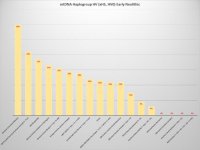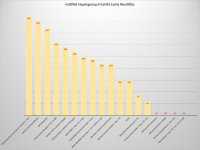I mean, when package was finished/collected and started to spread with steppe population.
Are you saying that Yamnaya is 40-50% CHG? We know genetics of CHG, it is impossible. When they say Yamnaya was 50% BA Armenian like, it was because stepped moved into Armenia during Bronze age, and made locals more similar to steppe.
They never said Yamnaya was about 50%
Bronze Age Armenian like.
This is what they said in Haak et al:
"This was likely due to admixture of EHG with a population related to
present-day Near Easterners, as the most negative f3-statistic in the Yamnaya (giving unambiguous evidence of admixture) is observed when we model them as a mixture of EHG and
present-day Near Eastern populations like Armenians (Z = -6.3; SI7).
That's a far different thing.
When more ancient Dna became available, this is what Lazaridis et al stated:
http://biorxiv.org/content/biorxiv/early/2015/02/10/013433.full.pdf
" We model each Test population (purple) as a mixture (pink) of a fixed reference population (blue) and a ghost population (orange) residing on the cline defined by two other populations (red and green) according to the visualization method of Supplementary Information, section 10. a,
Early/Middle Bronze Age steppe populations are a mixture of Iran_ChL and a population on the WHG→SHG cline. b, Scandinavian hunter–gatherers (SHG) are a mixture of WHG and a population on the Iran_ChL→Steppe_EMBA cline. c, Caucasus hunter– gatherers (CHG) are a mixture of Iran_N and both WHG and EHG. d,
Late Neolithic/Bronze Age Europeans are a mixture of the preceding Europe_MNChL population and a population with both EHG and Iran_ChL ancestry. e, Somali are a mixture of Mota49 and a population on the Iran_ChL→Levant_BA cline. f, Eastern European hunter–gatherers (EHG) are a mixture of WHG and a population on the Onge→Han cline."
Iran Chalcolithic according to his calculations represents 43 % of EM Bronze Age steppe people. Iran Chalcolithic itself is 63% CHG, 17% Iran Neolithic, and 20% Levant Neolithic.
So, according to the Reich Lab, not CHG, no, but a population from south of the Caucasus which moved north onto the steppe.
It went in all directions:
"Admixture from populations related to the Chalcolithic people of western Iran had a wide impact, consistent with contributing around 44% of the ancestry of Levantine Bronze Age populations in the south and about 33% of the ancestry of the Chalcolithic North-West Anatolians in the west."
@Absurdistan,
Has it occurred to you yet to wonder why almost no one responds to you positively?
The only reason I do is to correct your constant misstatements of fact.
@ Promenade,
Yes, he's been analyzed autosomally. You can't depend on yDna. After a number of generations, the autosomal signature originally tied to a certain y line, in this case Mesolithic H/G, may disappear.




